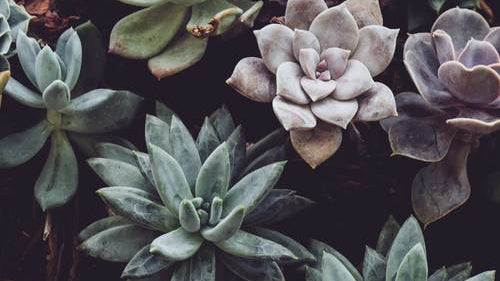
Succulents Complete Care Guide
If your home has become a graveyard of out-of-sorts orchids, struggling Snake Plants, or bleak bonsai trees – you’re not alone. Many of us have been there.
If you’re most certainly not ready for the responsibility of a pet (or worse, a child) – you’re in the right place.
If you’re living in a concrete jungle – we get it – things get a bit depressing. You need some greenery in your life. A recent study even found that plants can improve your mental health – making you happier and healthier.
Regardless of your caretaking history, we’ve got great news. It’s not too late to turn over a new leaf, become a plant-expert – a plantspert, if you will – and fill your home with joy.
Are you ready to start off with one of the easiest, low-maintenance plants around? Consider this your botany basic training to become the plant mom or dad you always knew you could.
Just grab a succulent and get reading!
Follow these simple steps and you’ll be well on your way to turning your home into one gigantic vivarium. Plants will love you, your neighbors will be jealous, and your mom will be proud.
Meet the Succulent
It all started with the Latin word “sucus”, which basically means to drink – specifically juice or sap. Now – before you get any ideas – let’s not go pouring apple juice in your succulent’s pot. Okay?
Anyways, succulents do suck up quite a bit of water, which they store in their thick, juicy leaves and stems. If you’ve ever forgotten to water your plants, this is truly great news for you, as these little (or large) guys are durable and ready for your inevitable neglect. As a drought resistant plant – even those accidental, homemade droughts – succulents are adept at soaking up any available water through their shallow root system.
It’s also important to mention that there is a huge variety of succulents. We aren’t going to get into that in detail here though. That’s a topic of a future blog, so stay tuned.
For now, we’ll suffice it to say that many of the plants you already know and love are succulents, including: Aloes, Agave, Cactus, Jade Plant, etc. Some other common houseplants like wandering jew are considered succulent since they store water in their leaves and stems. Even some orchids have adapted to the succulent lifestyle!
Okay, enough background. Let’s get to the care guide.
Light
If you’re living in a dungeon, maybe an under-the-stairwell closet (I’m looking at you, Harry Potter), or in a very cloudy cottage in the middle of a deeply wooded forest, a succulent is probably not a great choice for you.
Everyone else – with access to a window – you’re good to go, since succulents generally require a lot of light.
If you’re lacking significant natural light in your home, aim for a green succulent, rather than a colorful one, as they tend to do better indoors. Most plants enjoy red and orange light wavelengths, and since the color of a plant is technically the color reflecting off the plant, red succulents are more or less staring down the sun saying bring it on, I ain’t scared.
Look for a sunny, hot environment, and you’ll likely find a succulent – living its best life. While you’re at it, bring us along too; we could use some Vitamin D, as well. Regardless, succulents are going to demand the sunshine, and if they could talk, they’d tell you they want at least six to eight hours of that good stuff each day.
Now, we’re NOT telling you to sit with your plant all-day, every day, and move it around with the sun. That would be unreasonable.
All we’re telling you to do is put your plant near that window in your home – you know, the one that is consistently blinding you with sunlight each morning – and leave it there. That’ll do. If you happen to know how to use a compass, Google Maps, or this awesome tool we found, you’re looking for a south or west facing window.
Certain succulent plants, like the snake plant, can do pretty good in minimal light conditions. However, even those darkness lovers would love a couple hours of bright, albeit indirect sunshine each day.
You’ll know your succulent isn’t getting sufficient tanning time if it starts literally bending towards the light. For you vocabulary fanatics, this is called etiolation. Plants are smart (and apparently rather flexible), so if you don’t give them the light, they’ll find it. Obviously, don’t strive for this. Ideally, you want to prevent growing an etiolated, bent succulent.
Water
This section should probably be called “Don’t Water”. If you’re looking for a sure-fire way to kill your baby plant, over-watering is key. Your succulent’s roots will rot and potentially attract bugs. Who doesn’t love some bugs in their house? Literally everyone on earth.
Fortunately, follow this one simple rule and you’ll be well on your way to a happy, healthy succulent. We get it. Watering plants is fun; it’s responsible; it seems like the right thing to do. Wrong.
Take our advice and gone are the days of burying, flushing, burning, or binning your dead plant. No more plant funerals for you. You can say goodbye to that sadness.
So, here’s the rule:
It’s that easy. Just wait for the soil to completely dry out, then you’re ready to pull that trusty watering can out.
Please keep in mind, we are NOT saying to never water it, we’re just recommending you check the soil first. If you don’t water it at all, it’s going to die in one way or another eventually, so let’s stay away from that too. Okay?
If you’re still concerned that you’re not doing the whole watering thing right, we have another recommendation for you.
Avoid giving your plant small drinks (or spritzes) here and there, but rather, drench your plant, and let it drain completely. The trusty ol’ kitchen sink might be helpful here. This does require a pot with a drainage hole, but we’ll get into that in a little bit.
It all comes back to our golden rule. If you touch the soil and it’s still moist (or small chunks of dirt stick to your finger), it’s not ready for more water.
You can always set a reminder in your phone or physically write it in your calendar or planner to check the soil once a week.
It’s okay if it’s still wet, just set another reminder, and check back in a couple of days.
Potting and Soil
It’s important to remember here that your succulent is not a fish. It doesn’t want to go swimming. It wants to be happy and dry, like a baby.
Thus, unless you’re VERY CAREFUL, it needs a pot with a hole at the bottom so it can drain. That’s the first step. Goodbye water. We recommend terracotta pots for that extra breezy, porous clay goodness. Glazed ceramic can be dangerous if you’re not confident with your watering schedule.
Next, you’re going to be on the market for some quick draining soil. Standard potting soil just won’t cut it. Look for a cactus or succulent specific soil mix, which you should be able to find premixed at most garden centers.
Not a fan of the easy way out? It’s time for some creativity. You can try adding perlite – a fast drying soil amendment – or even finely ground bark to improve your succulent’s drying time. The trick is to use coarse, crumbly, high aeration material like crushed granite, pumice, chicken grit, or even non-soluble cat litter.
Now grab your pot, that succulent that just came in the mail, and you’re ready to plant. Don’t have a succulent yet? Like online shopping in your pajamas and avoiding crowds? Grab one from us before heading to your local garden store.
If you can follow a recipe with two ingredients, this should be a breeze for you. Just mix roughly half soil and half “draining materials” – as we mentioned above – to your pot and mix it, mix it real good. You’re looking to create a mix that is crumbly, not sticky, so keep that in mind. It can be helpful to wet a small portion of your mix to see if you’re getting the consistency right. If not – don’t panic – just add more of one ingredient or another, depending on which way your soil is leaning.
Fertilizer
If you notice your plant’s leaves are changing color – maybe pale or potentially yellow – it’s probably time to fertilize.
Look for a balanced fertilizer (i.e. NPK numbers 10-10-10 ), which simply means it’s equal parts nitrogen, phosphorus, and potassium, among other ingredients, of course. It’s important you’re not just dumping this fertilizer straight on your poor succulent, though. You’ll need to dilute first. Always follow instructions on the bottle. From there, you’re ready to fertilize.
There’s also various brands of succulent-specific plant food and fertilizers available. Just make sure you’re reading the directions on the package because applying fertilizer really is product specific. These options provide the long-lasting nourishment that your plant wants (and needs).
You’ll want to feed your plant fertilizer during the plant’s active growing season – particularly the spring. It may be useful to fertilize again in the late summer or early fall, but please, avoid fertilizing in the winter. Like bears (and chilly humans), most succulents are dormant – not growing – in the winter, so there’s no point.
Propagation
In our case, we’re going to use a leaf. For most succulents, you’ll need to carefully twist and pluck a leaf off of the succulent’s stem. You can pluck every single leaf off of older, well rooted plants – not only will they recover, they’ll grow in more bushy than before! Make sure it’s a clean break; if it isn’t clean, the leaf most likely won’t grow.
If you’re not of the fan of the yank and pull method – discussed above – you can also use scissors. Just cut off the top section/rosette of your succulent right above a leaf on the stem. You’ll want to remove enough of the lower leaves on the stem in order to pot it deep enough to anchor well in the soil.
From there, let the leaf or stem dry and scab over (yuck) for 1 to 3 days. Then, just plant the stem in, or place the leaf on the soil, water, and your new baby plant will be growing its own roots in no time at all. Soon, you’ll be the proud parent of your very own army of tiny succulents. Who needs a puppy, anyways?
You can generally expect to see results in about 2 to 3 weeks. Although it’s not as fast as Amazon Prime, you must admit – that’s pretty impressive. With bright light and occasional (remember the rule?) watering, you’ll have full size plants in a few months.
From there, you’ll follow all the same steps from the rest of this guide.

Leave a comment: